
Features
Structural
Training
Back to Basics: August 2013
In the June issue of Fire Fighting in Canada, we looked at how to bring a victim down a ground ladder horizontally with the victim facing the ladder.
July 29, 2013
By Mark van der Feyst
In the June issue of Fire Fighting in Canada, we looked at how to bring a victim down a ground ladder horizontally with the victim facing the ladder. The firefighter has his arms through the victim’s legs and under the victim’s arm to secure the victim to the ladder and to maintain control while descending. There are other methods to remove a victim down a ground ladder, such as the vertical victim technique. There are two variations to the vertical victim technique: the victim facing away from firefighter; and the victim facing the firefighter.
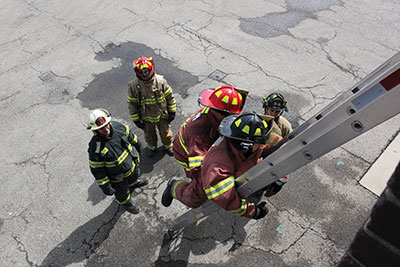 |
|
| Photo 1: With the ground ladder at a 75-degree angle, the weight of the firefighter and the victim is supported and transferred to the beams, and then directly to the ground. This is especially important to prevent the ladder from kicking out. |
|
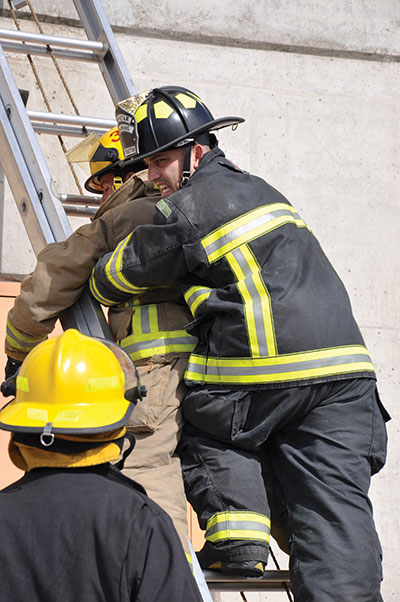 |
|
| Photo 2: The victim’s legs should be on the outside of the ladder beams. This will keep his legs clear from the firefighter’s climbing path and will prevent any tripping or leg entanglements. |
|
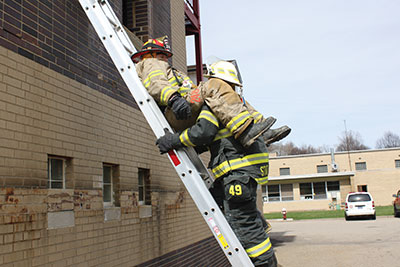 |
|
| Photo 3: In the case of a conscious victim, the victim’s legs will be resting on top of the firefighter’s shoulders. | |
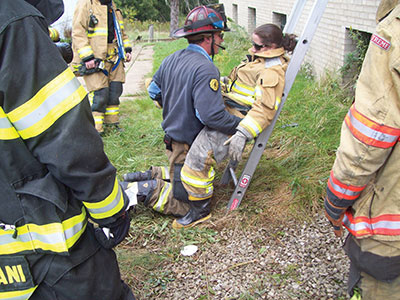 |
|
| Photo 4: With the victim resting on the firefighter’s one knee, the firefighter is able to disembark from the ladder on his own or wait for assistance with the removal. | |
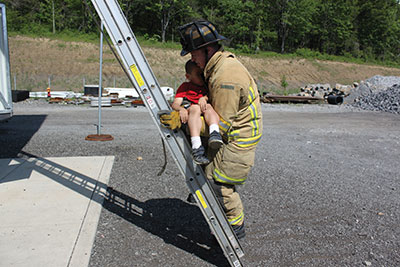 |
|
| Photo 5: When rescuing small children, firefighters can employ two methods for removal down ladders. The first involves holding the child horizontally as the firefighter descends the ladder. | |
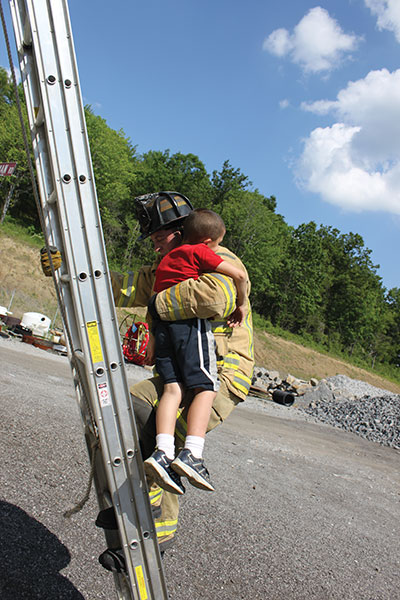 |
|
| Photo 6: The second method for rescuing a small child down a ladder involves holding the child in one arm as the firefighter climbs down the ladder. Photos by Mark van der Feyst |
Both of these removal techniques can be accomplished by just one firefighter. As long as control is maintained at all times, the firefighter will be able to bring the victim down the ladder and then get help at the bottom for removal to awaiting EMS crews. Much exertion will be required to descend the ground ladder with a viable victim – help will definitely be needed to drag or carry the victim to wherever EMS is set up.
The victim’s feet will have to be passed out the window first with the victim being either face up or face down. If the victim is conscious, he will face the firefighter. If the victim is unconscious, he will be facing away from the firefighter, since having an unconscious person vertically face the firefighter makes the removal very difficult and unstable.
In the technique in which the victim faces away from the firefighter, the firefighter will be positioned behind the victim, using his arms and one of his legs to support the victim’s weight. The angle of the ground ladder is important with this technique. As you can see in photo 1, the ground ladder is at a 75-degree angle. This allows the weight of the firefighter and the victim to be supported and transferred to the beams of the ladder, and then directly to the ground. With the ground ladder being on a hard surface, this is especially important to prevent the ladder from kicking out. Having another firefighter heeling the ladder will ensure that the ladder is stable.
The arms of the firefighter are right under the armpits of the victim, and his one leg is in between the victim’s legs. As seen in photo 2, the victim’s legs should be on the outside of the ladder beams. This will keep the victim’s legs clear from the firefighter’s climbing path and prevent any tripping or leg entanglements. The hard part with this technique is removing your leg from between the victim’s legs in order to step down to the next rung. To make this a little bit easier, the firefighter needs to roll his wrists upward, toward the ladder, before removing his leg. Doing this allows the weight of the victim to be somewhat relived from the firefighter’s knee, allowing the firefighter to remove his leg. Do this all the way down the ladder to the ground.
If the victim regains consciousness or starts to lose control, the firefighter can pull his body into the ladder and pin the victim in order to regain control. This is a very effective way to control the victim. Once at the bottom, the firefighter can drag the victim away from the ground ladder to awaiting EMS crews.
With the victim facing the firefighter, the weight of the victim will be resting on the shoulders of the firefighter, as well as on the ladder. In photo 3, you can see how the victim will sit on the ladder and his legs will be resting on top of the firefighter’s shoulders. This can be accomplished only if the victim is conscious.
The buttocks area of the victim should be close to the chest area of the firefighter. This will help with weight distribution and will reduce the strain on the firefighter’s arms. The firefighter will have his hands on the beams of the ladder, allowing him to slide his hands smoothly down as he descends. The back of the victim will slide down the rungs of the ladder. Depending on the size of the victim, part of his back will slide down the beams of the ladder. The rungs may lead to a rash on the victim’s back, but the victim will be out of the building, safe and alive.
Once at the bottom of the ladder, the firefighter can let the victim rest on his one knee. In photo 4, you can see how this is set up. With the victim resting on the firefighter’s knee, the victim can disembark from the ladder on his or her own, or wait for assistance.
When dealing with small children, the removal technique varies depending on the size of the child. A child can lie horizontally across the arms of the firefighter, as in photo 5, or be carried in one arm, as in photo 6. A child can also be passed off to another firefighter below, if there is more than one child to be removed.
Practising these removal techniques for victims of any size and age will help you gain confidence.
Mark van der Feyst is a 14-year veteran of the fire service. He works for the City of Woodstock Fire Department in Ontario. Mark instructs in Canada, the United States and India and is a local-level suppression instructor for the Pennsylvania State Fire Academy and an instructor for the Justice Institute of B.C. E-mail Mark at Mark@FireStarTraining.com
Print this page